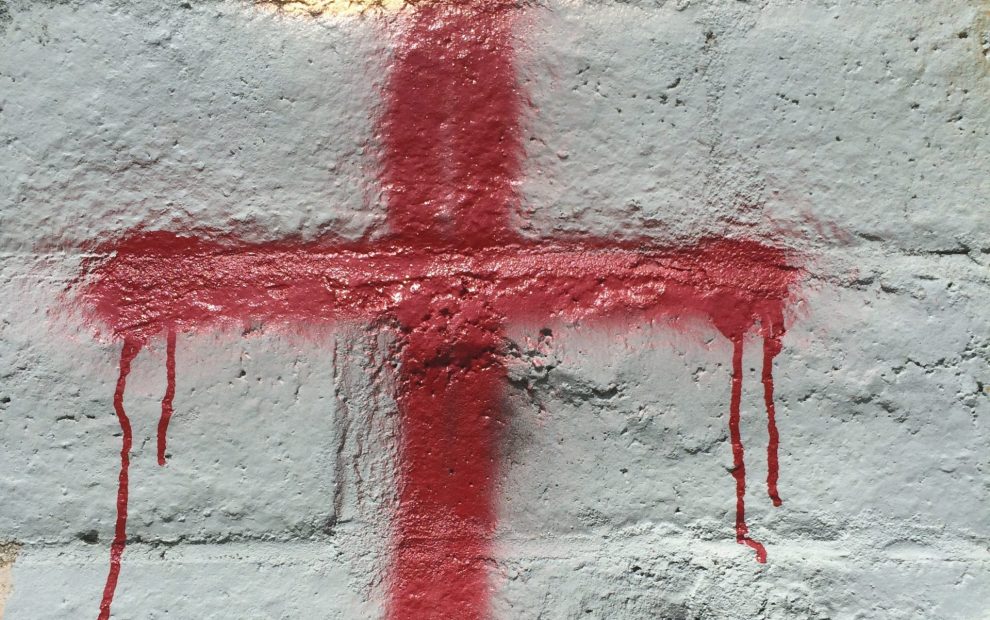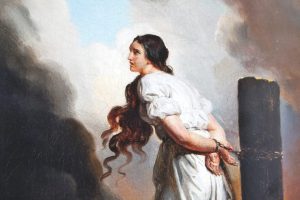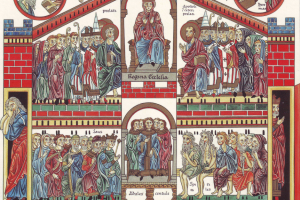In the foothills of British Columbia’s Rocky Mountains, about two miles north of the border with the United States, there is a small commune known as Hardy Mountain Doukhobor Village. The village—now abandoned—was built around 1912. This small community is one of the many small communities of Christians around the world who practice Christian anarchism.
The Doukhobors are a small group of Christians whose name comes from the Russian word for “Spirit-wrestlers.” They believe God is present in all things, including in each human person. For the Doukhobors, neither scripture, iconography, nor the Russian Orthodox Church could claim more authority for revealing God than a butterfly or a baby.
This resistance to iconography and the Russian state church prompted Tzar Nicholas I to exile the Doukhobors and other Anabaptist Christians in Russia to Ukraine. In exile, the Doukhobors looked for a friendly country in which to land.
In 1899, the group fled to Canada. Leo Tolstoy, the author of Anna Karenina and War and Peace, had sworn off writing fiction after he experienced a religious conversion, but when Tolstoy heard of the persecution the Doukhobors were facing, he quickly finished his novel Resurrection and donated the royalties to the Doukhobors’ travel fund.
But the Doukhobors faced persecution in their new home, too. They were given land to homestead in Saskatchewan, but they refused to swear allegiance to the Canadian government, so their land was forfeited. Many of them moved west, to British Columbia. They created villages, some with communal homes, some with private residences, all with a communally shared commitment to agriculture and prayer. Their motto was: “Toil and peaceful living.”
A splinter sect, the Sons of Freedom, was a more violent group. They resisted materialism by setting their homes on fire. They refused to send their children to the government’s public schools, and many of their children were taken away and put in Canada’s residential schools, where their home culture was disciplined out of them. Now, according to the most recent Canadian census data, there are only 1,675 Doukhobors left.
If you ask a Christian if they’re an anarchist (I did), many of them will tell you, “Absolutely not.” But a select few might say, “Of course: Christians were the first anarchists.” Indeed, Christianity has a long history of anarchism that dates back to the early Christians of scripture and continues to today.
The origins of anarchism
In order to understand Christian anarchism, it’s important to first define anarchy, which can mean, much like Paul was to his readers, “all things to all people.” Anarchism was coined in the 18th century during the French Revolution. It was originally a pejorative term meaning what it so often does today: chaos and disorder. “Mere anarchy is loosed upon the world,” as William Butler Yeats wrote in “The Second Coming,” the emblematic poem of the 20th century.
Forty years after the French Revolution, Pierre-Joseph Proudhon was the first philosopher to embrace the term to describe his political philosophy, which was grounded in mutual aid, shared property, eradication of inequality, and a rejection of capitalism.
Proudhon was not Christian. Like many democratically minded philosophers of the 19th century, Proudhon clashed with the hierarchy-heavy Roman Catholic Church due to his post-monarchical politics. Religion, in the form of the Catholic Church and state churches, seemed diametrically opposed to anarchism.
“I think of Christian anarchism as beginning with Tolstoy,” says Harry Murray, a retired professor of sociology at Nazareth College and a Catholic Worker.
In 1879, when he was 51, Tolstoy had a spiritual crisis. The son of nobility, he became profoundly critical of the bourgeois attitude in which he was raised, where he absorbed a preoccupation with worldly excellence, comfort, and status. “My only real faith at that time was a belief in perfection,” he writes of his interior conversion in A Confession, “a desire to be better, not before myself or before God, but before other people.”
A decade later, Tolstoy wrote The Kingdom of God Is Within You, a philosophical treatise in which he describes the Quakers, Hutterites, and Mennonites and their nonresistance pacifism and refusal to serve the state. “[They] assert that violence—and so military service—is incompatible with Christianity,” he writes.
Tolstoy’s anarchism was, at its root, a refusal to participate in the activities of the state, chiefly war. He also rejected hierarchical Christianity: The creed recited in churches, he felt, should be rejected in favor of the more primitive credo of the Sermon on the Mount. Because of this belief, the Russian Orthodox Church excommunicated him in 1901.
Tolstoy’s ideas had an impact on Mahatma Gandhi, who corresponded with Tolstoy as he began his own journey of nonviolence. Gandhi viewed the state as an instrument of violence and favored “enlightened anarchy” as his societal ideal. He developed the idea of swaraj, or self-rule, based in small-scale, voluntary communities. “In many ways it comes close to the notion of direct democracy,” Murray says. Decisions would be made communally: Think of a New England town meeting as depicted in the TV show Gilmore Girls.
Christians were anarchists first
Although anarchism did not develop into a political philosophy until the 19th century, many Christian anarchists—including Tolstoy—found seeds of the modern political philosophy in the earliest Jewish and Christian traditions. Jacques Ellul, a French philosopher and professor of sociology who influenced many 20th-century anarchists, mines the Bible for sources of anarchy in his 1988 book, Anarchy and Christianity.
One example Ellul draws from is in the Book of 1 Samuel. The prophet Samuel warns the Israelites, who are clamoring for a king, that the king will not give them the security and power they are seeking:
These will be the ways of the king who will reign over you. . . .
He will take the best of your fields and vineyards and olive orchards and give them to his courtiers.
He will take one-tenth of your grain and of your vineyards and give it to his officers and courtiers. . . .
He will take one-tenth of your flocks, and you shall be his slaves.
(1 Sam. 8:10–18)
“That’s the earliest anarchist statement around,” Murray says.
Although medieval and modern theologians tried to interpret the Sermon on the Mount as an eschatological promise or a personal mandate, early Christians saw it both as a social and personal ethic. The life and teachings of Jesus provide the fundamental principles of Christian anarchists: Do not resist evil, do not judge, and do not return evil for evil.
Christian anarchists continue to interpret the Sermon on the Mount as an ethic to be lived here and now to bring about the kingdom of God within and among us. The Christian community in Jerusalem, described in Acts chapters 2 and 4, matches the description of an anarchist’s ideal society. Scripture describes the disciples partaking in common prayer, common ownership of goods, and mutual aid.
But, within the first few generations after Jesus’ resurrection, it became clear that the world would not end now, Christ would not come again in triumph in the apostles’ lifetimes, and Christians would live in a world not ruled by Christ. Other ideas began to develop to answer the question of how the Christian, whose life is in Christ, should live in this world that rejected Jesus himself.
How were people to reconcile the idea that “my kingdom is not from this world,” as Jesus said (John 18:36) with the words of the author of first Peter: “For the Lord’s sake accept the authority of every human institution, whether of the emperor as supreme, or of governors, as sent by him to punish those who do wrong and to praise those who do right.” (1 Pet. 2:13–14).
Between the fall of Rome and Charlemagne’s restoration of the Holy Roman Empire in 800 C.E., monasteries of autonomous, locally governed communities of monks spread across the European continent. Monastic orders, though not technically anarchist, did practice something like Gandhi’s self-rule: They created self-sustained communities that supported literary practices such as illumination and bookmaking. They supported agriculture and nearby towns, and they sheltered travelers.
In 1618, the Protestant Reformation prompted the Thirty Years War, a series of bloody wars between rival Christian groups in Europe. Several Christian communities chose resistance to the state rather than the allying with political rule. Mennonites were part of this “Radical Reformation,” Christian sects who saw the political wars between members of Christ’s body as part of the problem. Mennonites and other Anabaptist communities refused to bear arms.
And yet, despite their critique of the state, many Christians—particularly peace churches—are skeptical of anarchists because of some non-Christian anarchists’ endorsement of violent revolution: the idea that the state can and should be resisted violently and through political revolution and the taking-up of arms.
“Mennonites aren’t all that positive about the state,” says Mennonite theologian Ted Grimsrud. But, he notes, that doesn’t mean they see themselves as anarchists. Rather, many Mennonites identify anarchists with their non-Christian counterparts who may opt for violent revolution. For this reason, Grimsrud finds the phrase “anarchistic Christianity” more helpful than Christian anarchism.
Another Anabaptist community is the Bruderhof, founded in 1920 by Eberhard Arnold in Germany. Arnold was inspired by many of the same social concerns that anarchism addresses and founded a community that held their possessions in common, attempted to form a classless society without wealth inequality, and—crucially, after the bloodiest war in Europe—refused to take up arms to kill another human. Today, there around 3,000 members worldwide and 16 communities in the United States.
Emmy Mandel, an author and archivist, lives in the Bruderhof community of Fox Hill, New York. Despite the structure of Bruderhof communities, Mandel agrees with Grimsrud’s hesitation to use the word anarchist. She says that anarchism, to her, means flouting the law, violence, disorder, and being anti-government. “Simply put, we want to live out the Sermon on the Mount,” Mandel says. Nevertheless, the Bruderhof, as well as the Amish, are sometimes seen as examples of Christian anarchism in practice.
The Catholic version of Christian anarchism
If some Christian groups are skeptical of using the term anarchist to describe their philosophy, anarchists are often skeptical of religion because of claims of religious authority. Meanwhile, Western Catholics, who are taught by a magisterium and led by an infallible pope in a small city state in Rome, might, understandably, think that Christian anarchism does not concern them.
And yet, the example of Christian anarchism interviewees for this story most frequently invoked was, in fact, Catholic: the Catholic Worker movement. The Catholic Worker movement, founded by Dorothy Day and Peter Maurin in 1933, promotes the mutual aid and cooperative economics that Kropotkin and other anarchists promote, the works of mercy and ethics of the Sermon on the Mount, and nonviolent resistance to the all-encroaching state.
The Catholic Worker movement is commonly called anarchist because its communities are autonomous: There is no central organizing committee, national association, or organization under a bishop or congregation like other lay ecclesial movements in the church.
Ammon Hennacy, a Catholic Worker and close collaborator of Dorothy Day in the 1950s, called himself an anarchist, which he defined as “someone who doesn’t need a cop to tell him what to do.” Murray also sees a strand of Christian anarchism in the Berrigan brothers—Daniel and Philip Berrigan—priests who resisted the draft, burned draft cards, were imprisoned, and refused to vote.
Robert Ludlow, one of the editors of the Catholic Worker paper in the 1940s, wrote a series of editorials on the question of Christian anarchism. He defines the Christian anarchist bluntly: “He is one who rejects the State as a desirable vehicle of government.” But, Ludlow felt, it was important to form a Christian anarchism rather than simply a distributism or collectivism, because the “anarchist position is the only one that is unmistakably opposed to the State and advocates its elimination.”
In the September 1949 edition of the Catholic Worker, Ludlow wrote that many of the movement’s members felt the pressing need to solve problems now, which requires aiding the state to find solutions like welfare, social security, food distribution or housing. But the risk of this sort of state-created solution is that Christians would forget their goal is also the abolition of the coercive rule of the state. The Christian’s goal is the creation of the kingdom of God, and they have a common communion that exists above and beyond the state.
The state, Ludlow wrote, takes the place of God’s position as a deity. The state is an “absolute,” or a false eternity, which falsely presents itself as an unchanging reality: “a focal point to which disjointed secular man can give allegiance.” Humans, he noted, need an eternity in which to root themselves and orient themselves around. The state slowly replaces God—the true eternity—with a temporal reality. “For the state is a jealous God and will stand no rival,” he wrote.
Hennacy says that when he first met Maurin in 1937, Maurin did not call himself an anarchist but preferred to call himself a personalist. “They’re not mutually exclusive, they sort of blend into each other,” says Murray. “It kind of blends into the Catholic doctrine on subsidiarity.”
Murray says that Maurin’s preference for the title “personalist communitarian” points to one of the problems with anarchism—it can devolve into “rugged individualism,” as Peter Maurin would call it. Maurin practiced “gentle personalism,” which “emphasizes the person as a social and spiritual being,” Murray says, “not just an individual unit.”
In “Aims and Purposes of the Catholic Worker,” published in the February 1940 edition of the paper, Day describes the social order she believes is a result of the doctrine of the mystical body of Christ, the cornerstone of Day’s political theology:
This teaching, the doctrine of the Mystical Body of Christ, involves today the issue of unions (where men call each other brothers); it involves the racial question; it involves cooperatives, credit unions, crafts; it involves Houses of Hospitality and Farming Communes. It is with all these means that we can live as though we believed indeed that we are all members one of another, knowing that when “the health of one member suffers, the health of the whole body is lowered.”
Ultimately, Day believed, no one can say to their sibling—what have you to do with me? Our well-being is bound up in our neighbor’s. For Day, simply resisting the authoritarian state is not enough; people also need to care for one another.
The revolution of the Spirit
In the wake of George Floyd’s murder in 2020 and the mutual aid networks that cropped up around the country during the pandemic and the racial reckoning of that summer, one theologian found himself compelled to explore the parallels between mutual aid, anarchy, and his own Christian faith.
“I am a Black pacificist utopian municipalist anarchist—say that three times fast,” writes Terry J. Stokes in his new book, Jesus and the Abolitionists: How Anarchist Christianity Empowers the People (Broadleaf). Stokes shares how he came to understand anarchism in his own context as a Black pastor who journeyed from a conservative evangelical understanding of scripture to a more anarchist systematic theology. He believes that violence prevention programs and restorative justice programs, which many Christians participate in today, are a form of anarchism, although they may not know it. These programs create a more personalist, holistic form of community organizing outside of or parallel to the apparatus of the state.
The bulk of Stokes’ manifesto is dedicated to sketching out an anarchistic systematic theology—from the Trinity to the eschaton. Christian anarchism, unlike regular anarchism, is primarily concerned with this spiritual reality that reorders our physical reality.
Such a mindset aligns well with that of Day and Maurin, who believed that Christianity provides us with the map to social reconstruction—one must begin, as Day says, with the revolution of our heart.
The goal of the Christian anarchist is the long revolution of life in Christ. “A revolution is supposed to be a change that turns everything completely around. But the ideology of political revolution will never change anything except appearances. . . . The only influence that can really upset the injustice and iniquity of men is the power that breathes in Christian tradition,” writes Thomas Merton in New Seeds of Contemplation.
In other words, even anarchists, who eschew all hierarchies, are vulnerable to the same old ruts of power to which humans have always been tempted: the strong preying on the weak, racism, patriarchy, clericalism, resentment, envy. The ability to live out the Sermon on the Mount like a Christian anarchist—through noncooperation with evil, resistance to the state, and reconstructing the social order to reflect the mystical body of Christ—is only as strong as each person’s ability to examine their conscience, let go of power, listen, read the signs of the times, discern, grow, and change. The Rule of Benedict calls this conversatio morum—or conversion of life. And that unglamorous revolution of the heart is not televised.
This article also appears in the July 2024 issue of U.S. Catholic (Vol. 89, No. 7, pages 20-24). Click here to subscribe to the magazine.
Image: Shutterstock/Jeff Smith – Perspectives













Add comment